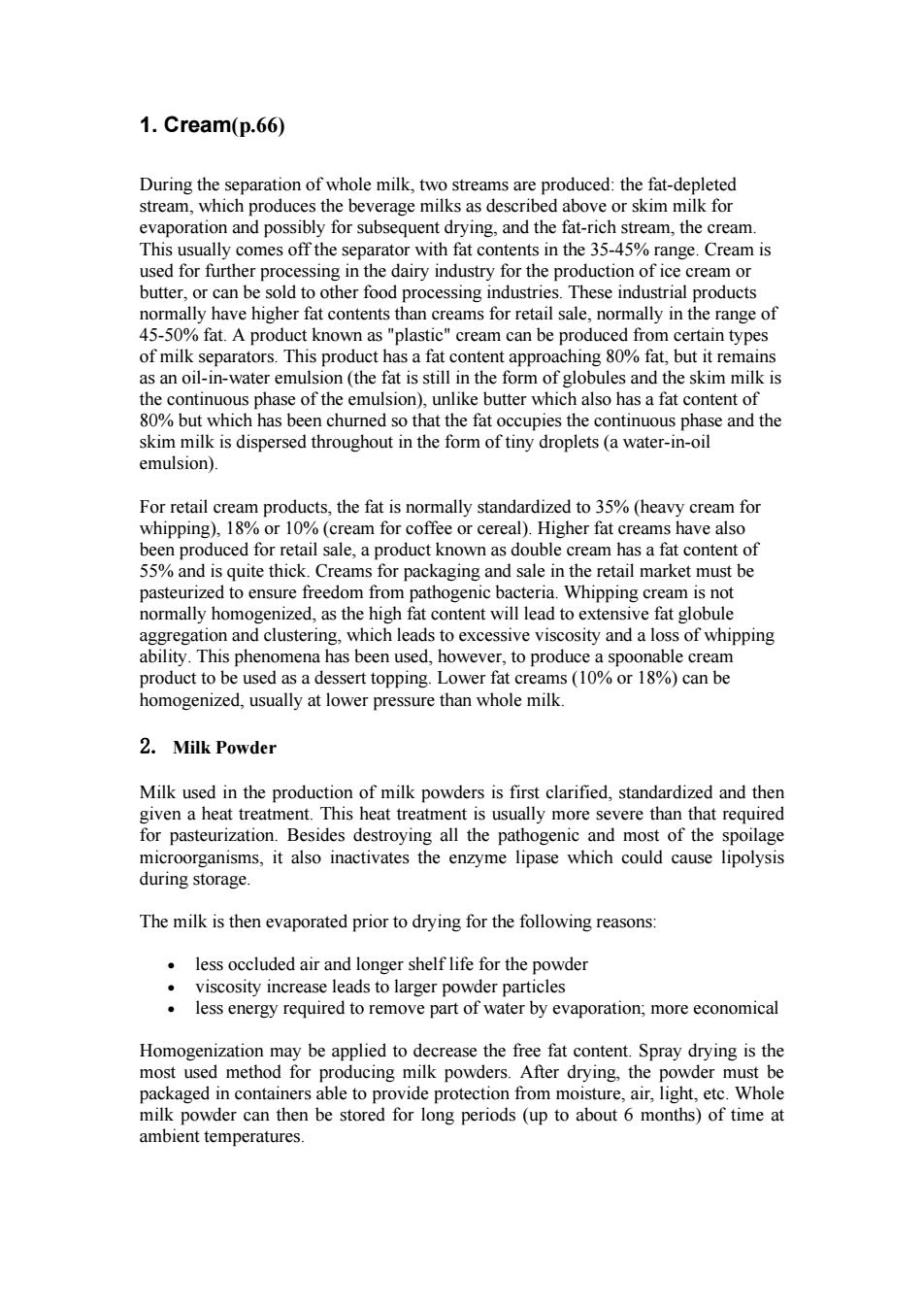正在加载图片...

1.Cream(p.66) During thes of hoe the fat-deplete an pro age m and the 00 the Thi ith f nte in the 35 450/ used for further ocessing in the dairy industry for the duction of ic creamo butter or can he old to other food processing industri These industrial normally have higher fat contents than creams for retail sale.normally in the range of 45-50%fat.A product known as"plastic"cream can be produced from certain types of milk separators.This product has a fat content approaching 80%fat,but it remains as an oil-in-water emulsion(the fat is still in the form of globules and the skim milk is the continuous phase of the emulsion),unlike butter which also has a fat content of 80%but which has been churned so t at the fat occupies the continuous phase and the skim milk is dispersed throughout in the form of tiny droplets(a water-in-oil emulsion) )1 prod For retail the fat is nor eam for gher fa ave of th ust be asteu sure freedom fror atho normally hom zed as the high fat content will lead to ey sive fat globule regation and clustering.which leads to excessive viscosity and a loss of whipping ability.This phenomena has been used,however,to produce a spoonable cream product to be used as a dessert topping.Lower fat creams(10%or 18%)can be homogenized,usually at lower pressure than whole milk. 2.Milk Powder Milk used in the production of milk powders is first clarified,standardized and ther eiven a heat tr nt This heat treatment is usually more evere than that requi ired for pasteurization.Besides destroying all the pathogenic and most of the sp ilage microorganisms,it also inactivates the enzyme lipase which could cause lipolysis during storage. The milk is then evaporated prior to drying for the following reasons: less occluded air and longer shelf life for the powder viscosity increase leads to larger powder particles less energy required to remove part of water by evaporation:more economical Homogeniza a y be applied to e free fat content Spray drying is th ethod r producing n K pow After drying. de n t be store d ng per (up ure. out 6 m ratures 1. Cream(p.66) During the separation of whole milk, two streams are produced: the fat-depleted stream, which produces the beverage milks as described above or skim milk for evaporation and possibly for subsequent drying, and the fat-rich stream, the cream. This usually comes off the separator with fat contents in the 35-45% range. Cream is used for further processing in the dairy industry for the production of ice cream or butter, or can be sold to other food processing industries. These industrial products normally have higher fat contents than creams for retail sale, normally in the range of 45-50% fat. A product known as "plastic" cream can be produced from certain types of milk separators. This product has a fat content approaching 80% fat, but it remains as an oil-in-water emulsion (the fat is still in the form of globules and the skim milk is the continuous phase of the emulsion), unlike butter which also has a fat content of 80% but which has been churned so that the fat occupies the continuous phase and the skim milk is dispersed throughout in the form of tiny droplets (a water-in-oil emulsion). For retail cream products, the fat is normally standardized to 35% (heavy cream for whipping), 18% or 10% (cream for coffee or cereal). Higher fat creams have also been produced for retail sale, a product known as double cream has a fat content of 55% and is quite thick. Creams for packaging and sale in the retail market must be pasteurized to ensure freedom from pathogenic bacteria. Whipping cream is not normally homogenized, as the high fat content will lead to extensive fat globule aggregation and clustering, which leads to excessive viscosity and a loss of whipping ability. This phenomena has been used, however, to produce a spoonable cream product to be used as a dessert topping. Lower fat creams (10% or 18%) can be homogenized, usually at lower pressure than whole milk. 2. Milk Powder Milk used in the production of milk powders is first clarified, standardized and then given a heat treatment. This heat treatment is usually more severe than that required for pasteurization. Besides destroying all the pathogenic and most of the spoilage microorganisms, it also inactivates the enzyme lipase which could cause lipolysis during storage. The milk is then evaporated prior to drying for the following reasons: • less occluded air and longer shelf life for the powder • viscosity increase leads to larger powder particles • less energy required to remove part of water by evaporation; more economical Homogenization may be applied to decrease the free fat content. Spray drying is the most used method for producing milk powders. After drying, the powder must be packaged in containers able to provide protection from moisture, air, light, etc. Whole milk powder can then be stored for long periods (up to about 6 months) of time at ambient temperatures